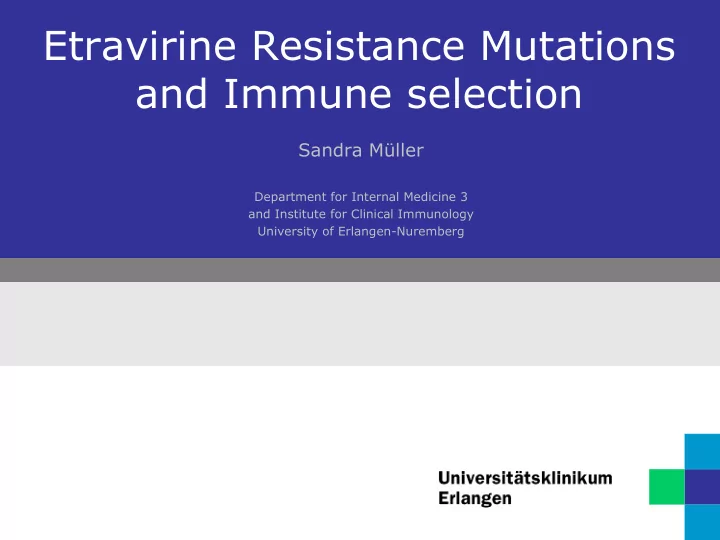

Etravirine Resistance Mutations and Immune selection Sandra Müller Department for Internal Medicine 3 and Institute for Clinical Immunology University of Erlangen-Nuremberg
Background information … about • Peptide presentation • Epitopes • HLA and disease progression • Escape mutation was given by Finja in contrast to Finja’s project we analyse correlation between HLA alleles and the occurrence of drug resistance mutations in patients without primary resistance e.g. Mueller et al. 2007 JVi 2
Etravirine Resistance non-nucleoside reverse transcriptase inhibitor (NNRTI) • high genetic barrier to the development of resistance • active against HIV-1 strains with multiple NNRTI • resistance mutations resistance is evaluated by a score system • 3
Etravirine Tibotech Resistance Score 4
Etravirine Resistance Score - revised Monogram score: New algorithm for detecting resistance to ETR based on correlation between genotypic data and phenotypic response in Monogram Assay More Mutations play a role new aa residues were included other exchanges for some exchanges score changed Mojgan Haddad, Croi 2010 Poster 574 5
Aim of Study – Interaction CTL and ETR Resistance? Analyze influence of immune selection on ETR drug resistance mutations Cohort of 237 chronically infected HIV-1 patients 107 patients with out therapy before resistance testing 87 patients were NNRTI experienced 43 patients who were on therapy prior to resistance testing but had no NNRTI 6
Methods serological or/and genotypic HLA-typing was performed – HLA A, HLA B and HLA Cw were determined HIV-1 RT sequences were determined (Resistance testing) univariate correlations were evaluated by Fisher’s exact test Next step: results will be verified in biological assays: γ -interferon ELISPOT analyses restriction analyses standard Cr51 release assays 7
Results – correlations between ETR resistance mutation and HLA alleles B65 A68 B62 A36 B58 A33 A31 B57 B44 A26 A25 B07 A24 B35 A23 B18 A11 B13 A3 Y188L K103R E138A V179D M230L V179T Y181C Y181I V106I V189I A98G V179I V90I G190A K103R E138A V179D M230L K101Q Y181C V106I V189I V179I V90I V179 Y181 all patients drug naive patients Cw7 NNRTI experienced patients Cw5 Cw4 Patients on NNRTI free therapies Cw3 Resina patients Cw2 K103R E138A M230L V179D Y181C G190S V179T Y181I A98G V106I V179E V189I V90I 8
Results – Described Epitopes Correlation between E138A and HLA-B*18 P=0.017 Odds ratio=26.118 reference sequence: YTAFTIPSINN E TPGIRYQYNVLP described epitope: N E TPGIRYQY TBTC score 1 .5 Mono score 3 9
Results – Potential Epitopes V90I reference sequence: RELNKRTQDFWE V QLGIPHPAGLK potential epitopes: HLA-A*68: syfpeithi E V QLGIPHP HLA-A*26: NetChop proteasome cleavage ELNKRTQDFwe v HLA-B*13 TQDFWE V QL K103R reference sequence: VQLGIPHPAGLKK K KSVTVLDVGDA potential epitopes: HLA-B*35: ELF HPAGLKK K K HLA-B*35: ELF PAGLKK K KS HLA-Cw*0301: ELF KK K KSVTVL HLA-Cw*0702: ELF KK K KSVTVL V106I reference sequence: HPAGLKKKKS V TVLDVGDAYF potential epitopes: HLA-A*11: syfpeithi S V TVLDVGD HLA-A*11: NetChop proteasome cleavage HPAGLKKKKs v V179I/D reference sequence: LEPFRKQNPDI V IYQYMDDLCVGS potential epitopes: HLA-B*6802 I V IYQYMDDL HLA-B*65: syfpeithi RKQNPDI V HLA-Cw*0301: ELF RKQNPDI V I HLA-Cw*0301: ELF PDI V IYQYM 10
Results – Recognition of VIYQYMDDL Chromium Release Assay Recognition in HLA-A*02+ patients V IYQYMDDL VL9 includes aa position 179 I-------- V179E leads to escape T-------- Monogram score: 3 E-------- 0 10 20 30 40 50 60 70 80 % Specific Lysis A*02 and A*68 belong to the same HLA supertype A*0201 x[LM]xxxxxx[VL] A*0205 x[V(QL)]xxxxxx[L] A*6802 x[TV]xxxxxx[VL] 11
Conclusion ETR m utations could be assigned to specific HLA alleles Potential epitopes w ere found in the respective regions of HI V-1 RT E1 3 8 A correlates to HLA B* 1 8 , lies in a HLA B* 1 8 epitope and m ost likely lead to im m une escape I n HLA A* 0 2 + patients V1 7 9 E is an escape m utation Please send us blood sam ples from patients show ing Etravirine resistance m utations. 12
Thanks to… Thom as Harrer Rolf Kaiser Kathrin Eism ann Finja Schw eizer Silke Bergm ann and colleagues Melanie Leykauf Ellen Harrer RESI NA Hauke W alter Bernd Spriew ald DFG,I ZKF, Hector Stiftung Thom as‘ Group in Erlangen HI V Kom petenznetz All Patients taking part in our studies 13
Fortsetzung Epitope V179 reference sequence: LEPFRKQNPDI V IYQYMDDLCVGS potential epitopes: HLA-B*6802 V IYQYMDDL HLA-Cw*0301: ELF RKQNPDI V I HLA-Cw*0401: ELF NPDI V IYQY HLA-Cw*0301: ELF PDI V IYQYM HLA-Cw*0301: ELF V IYQYMDDL Y181 reference sequence: PFRKQNPDIVIYQYMDDLCVGSDL potential epitopes: FRKQNPDIVi y HLA B*3901 ELF; syfpeithi, potential CS HLA A*03: syfpeithi KQNPDIVI Y HLA B*3902 syfpeithi, potential CS RKQNPDIVI V189I reference sequence: IVIYQYMDDLC V GSDLEIGQHRTK potential epitopes: v gSDLEIGQHR HLA A33 ELF; potential CS 14
Fortsetzung Epitope G190S reference sequence: IVIYQYMDDLC V GSDLEIGQHRTK potential epitopes: v gSDLEIGQHR HLA A33 ELF; potential CS HLA B*3902 syfpeithi YQYMDDLC V M230L reference sequence: KHQKEPPFLW M GYELHPDKWTVQ potential epitopes: PFLW M GYEL NetChop WB GYELHPDKW evtl W als cleavage site 15
Recommend
More recommend